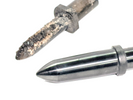
COATINGS - Extreme Temperatures with ACTIVSTONE BK
, by Steve Coulter, 1 min reading time

, by Steve Coulter, 1 min reading time
In a weld cell, there are many enemies that can attack the integrity of a slag/spatter protective coating: abrasion can scrape or wear off the coating in time, impact can chip or pulverize the coating, exposing the unprotected substrate - and then there's HEAT.
Depending on the component location, heat can pose high demands on a protective coating as some applications in welding and casting expose parts to extreme burst heat, and for long durations. ACTIVSTONE BK is formulated with this particularly in mind.
ACTIVSTONE BK - The component to be coated must be thermally stable up at 500° Fahrenheit, where it is suspended in a vacuum chamber where an intense arc reacts with a source material to condense onto the part surface. So stainless steel, carbon and alloy steels are excellent candidates.
The process provides a very uniform coating, and can be controlled from .5um to 5um depending on the application requirements and methods of processing. The result is no delamination or cracking, and super high integrity at temperature extremes - even for sustained durations and cycles in the the millions.

We subjected these 2 pins (above) to extreme temperatures with molten splash and in close proximity to an intense electric arc - you can see the results of the uncoated pin, and the ACTIVSTONE BK (3.5um) coated pin after cleaning, with coating very much in tact.
ACTIVSTONE BK is not for every application and every part - some of its limitations are parts size, quality of part condition (used parts must be evaluated as to whether or not they are suitable candidates for the process) and a substantial pre-processing and cleaning may escalate costs.
A very good application is for small complex details - especially where a uniformly thin (0.5um to 2um) coating is needed.
This part was a spatter magnet for a customer, and 2um thick ACTIVSTONE BK coating significantly reduced the maintenance interval, and replacement cost of tooling.